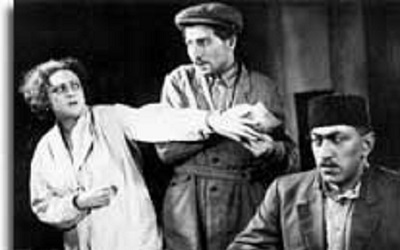The first film distribution offices were established in Baku, Tbilisi and Yerevan by stock companies (trade houses) founded by the Pirone brothers in the Caucasus in 1915. That same year, the company started the production of Azerbaijan`s first feature film, "The Reign of Oil and Millions", based on M. Musabeyov`s novel of the same name, with the help of the financing of oil tycoons. Film director B. N. Svetlov was invited from St. Petersburg to produce the film. The landscape scenes were shot in Baku and suburban villages, while the indoor scenes were shot in a Tbilisi studio. The role of Lutveli bey was played by N.Arablinsky. The first comedy in Azerbaijan was produced based on the "Arshyn Mal Alan" opera by U. Hajibeyov in Baku in 1916. The full-length movie "Celebrations of the Anniversary of Independence of Azerbaijan" went on screen in 1919.
The Photo and Film Organization of Azerbaijan (PFOA) was establishment in 1923. The PFOA was involved in nationalization and integration of photo agencies, cinemas and movie distribution offices, owned by individual businessmen. The PFOA was at that time also operating the cinemas Teyyare, Edison, Million, Ladya, Medenchi and others in Baku.
The PFOA-produced bi-serial "The Maiden Tower Legeng" (film director - V. V. Vallyuzek) was screened in 1924. The film producers highlighted Eastern exotics in this ethnography-oriented movie.
In 1925, Sh. Mahmudbayov initiated the establishment of a studio under the PFOA for training film directors and actors in Azerbaijan. This is the studio where J. Jabbarly, M. Mikayilov, A. Tahirov and others studied. Such prominent film directors as V. I. Pugovkin, I. A. Shevchenko. N. M. Shengelaya, M. E. Chiaureli, as well as cameramen G. M. Lembek, V. R. Lemke, A. V. Galperin, I. S. Frolov, A. M. Feldman, L. L. Kosmatov, V. M. Shneyder and others were invited to Baku, while D.Dzhabbarly, A.M.Sherifzade and others were involved in movie production for the purposes of improving movie production quality and the development of national resources.
The PFOA was later known as "Azdovletkino", (1926-1930),"Azerkino" (1930-1933), Azfilm (1933), Azerdovletsenayesi (1934), Azerfilm (1935-1940) and The Baku Film Studio (1941-1959). It was named J.Jabbarly`s Azerbaycanfilm studio in 1961.
The struggle against ignorance and illiteracy, the revolution, and rights of women were the main subjects of Azeri films in the 1920s. The most successful ones were Bismillah (1925, film directors - A. M. Sherifzade and A. Valovo), "A House On the Volcano" (1929, film director - A .I. Bek-Nazarov, in cooperation with Azerkino ), "Hadzhi Gara" (1929, film director - A. M. Sherifzade), as well as "Sevil" (1929, film director - A. I. Bek-Nazarov), which pictured the image of an Azeri woman struggling for freedom.
In the twenties of XX century local cameramen and reps of foreign movie companies were shooting in Baku documentary films and newsreel on life of city, oil mines. In 1920 first newsreel titled "Official march of 9 golden Army in Baku" was shot. The same year newsreel titled "First convention of eastern nations" was created. Next years newsreels on certain events were prepared: "3rd anniversary of Soviet Azerbaijan" (1923), "Fire in Surakhani oil mines" (1923), "Funeral of Nariman Narimanov" (1925), "Arrival of M.Frunze to Baku" (1925) and etc documentary films, as well popular science films started to be produced.
In 1925 director A.M.Sherifzade completed shooting of the film "Journey to Azerbaijan" on cultural and economic life of republic. In the twenties, beside historical documentaries, production of newsreel "Azerbaijani screen" started (4-5 issues a year) in Azeri cinema that was familiarizing the audience with successes of republic in economic and cultural fields. These years talented directors such as M.Mikayilov, A.A.Litvinov, A.A.Makovsky, cameramen like V.P.Lemke, A.Valovoy, A.Tolchan, I.S.Tartakovsky were working in Azeri documentary. B.V.Pumyansky, S.Badalov, V.Yeremeyev, A.Hasanov, E.Elekberov and others started to work in this field in the thirties. Movies of these masters reflected life of republic, kolkhoz construction, successes in cultural field, equipment of oil industry with new technique in first five years and etc. Efforts in field of creation of image of perfect man in frame of documentary were artistic achievements of that time.
The movies produced in the early 1930s are features picturing contemporary life, the history and socialist revolution, such as Latif, Ismet (1930, 1934, film director - M. Mikailov), The Diamond and The New Horizon (1936, 1940, film directors - A. Guliyev and G. M. Braginsky), The Baku Residents (1938, film director - V. V. Turin), The Villagers (1940, film director - S. Mardanov).
More about:
















































